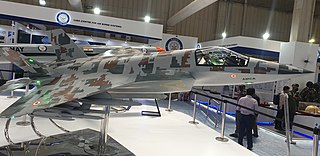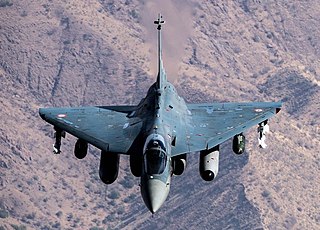
Hindustan Aeronautics Limited (HAL) is an Indian public sector aerospace and defence company, headquartered in Bangalore. Established on 23 December 1940, HAL is one of the oldest and largest aerospace and defence manufacturers in the world. HAL began aircraft manufacturing as early as 1942 with licensed production of Harlow PC-5, Curtiss P-36 Hawk and Vultee A-31 Vengeance for the Indian Air Force. HAL currently has 11 dedicated Research and development (R&D) centres and 21 manufacturing divisions under 4 production units spread across India. HAL is managed by a board of directors appointed by the President of India through the Ministry of Defence, Government of India. HAL is currently involved in designing and manufacturing of fighter jets, helicopters, jet engine and marine gas turbine engine, avionics, software development, spares supply, overhauling and upgrading of Indian military aircraft.

STOBAR is a system used for the launch and recovery of aircraft from the deck of an aircraft carrier, combining elements of "short take-off and vertical landing" (STOVL) with "catapult-assisted take-off, barrier-arrested recovery" (CATOBAR).

The HAL Tejas is an Indian single-engine, 4.5 generation delta wing multirole combat aircraft designed by the Aeronautical Development Agency (ADA) and manufactured by Hindustan Aeronautics Limited (HAL) for the Indian Air Force (IAF) and Indian Navy. Tejas made its first flight in 2001 and entered into service with the IAF in 2015. In 2003, the aircraft was officially named "Tejas". Currently Tejas is the smallest and lightest in its class of supersonic combat aircraft.
Aero India is a biennial air show and aviation exhibition held in Bengaluru, India at the Yelahanka Air Force Station. It is organised by the Defence Exhibition Organisation, Ministry of Defence.

The Advanced Medium Combat Aircraft (AMCA) is an Indian single-seat, twin-engine, all-weather fifth-generation stealth, multirole combat aircraft being developed for the Indian Air Force and the Indian Navy. The Mark-1 variant of the aircraft will be a fifth generation fighter while the Mark-2 variant will have sixth-generation technologies. The aircraft is designed by the Aeronautical Development Agency (ADA) - an aircraft design agency under MoD. A Special Purpose Vehicle (SPV) consisting of ADA, Hindustan Aeronautics Limited (HAL) and a private company is being formed for the development and production of AMCA. In March 2024, the project received approval from India's Cabinet Committee on Security for the prototype development.

The GTRE GTX-35VS Kaveri is an afterburning turbofan project developed by the Gas Turbine Research Establishment (GTRE), a lab under the Defence Research and Development Organisation (DRDO) in Bengaluru, India. An Indian design, the Kaveri was originally intended to power production models of the HAL Tejas Light Combat Aircraft (LCA) developed by Hindustan Aeronautics Limited. However, the Kaveri programme failed to satisfy the necessary technical requirements or keep up with its envisaged timelines and was officially delinked from the Tejas programme in September 2008.
The Indian Naval Air Arm is the aviation branch and a fighting arm of the Indian Navy which is tasked to provide an aircraft carrier-based strike capability, fleet air defence, maritime reconnaissance, and anti-submarine warfare.

Gas Turbine Research Establishment (GTRE) is a laboratory of the Defence Research and Development Organisation (DRDO). Located in Bengaluru, its primary function is research and development of aero gas-turbines for Military aircraft. As a spin-off effect, GTRE has been developing marine gas-turbines also.

This is a timeline of the development of the HAL Tejas, a light-weight, multirole fighter aircraft manufactured by Hindustan Aeronautics Limited.

Ghatak is an autonomous jet powered stealthy unmanned combat air vehicle (UCAV), being developed by Aeronautical Development Establishment (ADE) of the Defence Research and Development Organisation (DRDO) for the Indian Air Force. The design work on the UCAV is to be carried out by Aeronautical Development Agency (ADA). Autonomous Unmanned Research Aircraft (AURA) was a tentative name for the UCAV. Details of the project are classified.
The Indian Air Force has been undergoing a modernization program to replace and upgrade outdated equipment since the late 1990s to meet modern standards. For that reason, it has started procuring and developing aircraft, weapons, associated technologies, and infrastructures. Some of these programs date back to the late 1980s. The primary focus of current modernization and upgrades is to replace aircraft purchased from the Soviet Union that currently form the backbone of the Air Force.

INS Hansa, is an Indian naval air station located near Dabolim in Goa, India. It is India's biggest naval airbase. The military air base has a civil enclave, that operates as Dabolim Airport.

INS Vikrant is an aircraft carrier in service with Indian Navy. The carrier is India's fourth carrier and the first to be built in India. It was constructed by the Cochin Shipyard Limited (CSL) in Kochi, Kerala. The namesake Vikrant is a tribute to India's first aircraft carrier INS Vikrant (1961). Vikrant means "courageous" in Sanskrit. The motto of the ship, "जयेम सम् युधिस्पृधः" (Sanskrit), means "I defeat those who dare to challenge me" (English).

No. 45 Squadron Indian Air Force is a Fighter Squadron internally based at Sulur AFS, Tamil Nadu. The squadron operates the indigenous HAL Tejas fighter from 1 July 2016. The squadron was initially based at Bangalore, Karnataka and later shifted to its main base in Sulur from 1 June 2018.

Uttam is a solid-state gallium arsenide (GaAs) based active electronically scanned array (AESA) radar under development by the Electronics and Radar Development Establishment (LRDE), a laboratory of the Indian Defence Research and Development Organisation (DRDO). It is a low probability of intercept radar. It is a liquid cooled AESA radar featuring quad band modules that can be stacked to form a larger unit. This allows the manufacturer to scale the radar to be used in larger aircraft.

The HAL Tejas Mark 2, or Medium Weight Fighter (MWF), is an Indian single-engine, canard delta wing, multirole combat aircraft designed by the Aeronautical Development Agency (ADA) in collaboration with Aircraft Research and Design Centre (ARDC) of Hindustan Aeronautics Limited (HAL) for the Indian Air Force (IAF). It is a further development of the HAL Tejas, with an elongated airframe, close coupled canards, new sensors, and a more powerful engine.

The HAL Combat Air Teaming System (CATS) is an Indian unmanned and manned combat aircraft air teaming system being developed by Hindustan Aeronautics Limited (HAL). The system will consist of a manned fighter aircraft acting as "mothership" of the system and a set of swarming UAVs and UCAVs governed by the mothership aircraft. A twin-seated HAL Tejas is likely to be the mothership aircraft. Various other sub components of the system are currently under development and will be jointly produced by HAL, National Aerospace Laboratories (NAL), Defence Research and Development Organisation (DRDO) and Newspace Research & Technologies.

CATS Warrior is a part of the HAL Combat Air Teaming System program. Its work is believed to have started in early 2019 under a Public Private Partnership (PPP) between the state owned Hindustan Aeronautics Limited (HAL) and an Indian private startup, Newspace R&D. HAL has done an initial investment of ₹400 crore in CATS Warriors & in Aero India 2021 a full-scale mock-up model was presented for the first time.















